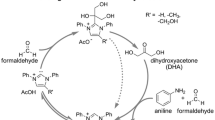Summary
The decreasing reactivity of tri-, di- and monochlorotriazine was utilized for the solid-phase construction of a combinatorial library with three randomized positions, using 20 amino acids and 50 amines as building blocks. The first chlorine atom was selectively substituted by coupling a large excess of trichlorotriazine to the support-bound amino acid, thus avoiding simultaneous substitution of the second chlorine. The second and third diversity positions were selectively introduced by coupling amines at different temperatures. Mixtures of model compounds were synthesized and analyzed, showing the correct representation of all expected components. A library composed of 12 000 compounds was generated using this method.
Similar content being viewed by others
References
Terrett, N.K., Gardner, M., Gordon, D.W., Kobylecki, R.J. and Steele, X.,Combinatorial synthesis: The design of compound libraries and their application to drug discovery, Tetrahedron, 51 (1995) 8135–8173.
Thompson, L.A. and Ellman, J.A.,Synthesis and applications of small-molecule libraries, Chem. Rev., 96 (1996) 555–600.
Ellman, J.A.,Design, synthesis and evaluation of small-molecule libraries, Acc. Chem. Res., 29 (1996) 132–143.
Früchtel, J.S. and Jung, G.,Organic chemistry on solid supports, Angew. Chem. Int. Ed. Engl., 35 (1996) 17–42.
Rinnová, M. and Lebl, M.,Molecular diversity and libraries of structures: Synthesis and screening, Coll. Czech. Chem. Commun., 61 (1996) 171–231.
Kasal, A., Kohout, L. and Lebl, M.,Synthesis of a scaffold for the creation of non-peptide libraries, Coll. Czech. Chem. Commun., 60 (1995) 2147–2155.
Pátek, M., Drake, B. and Lebl, M.,All-cis cyclopentane scaffolding for combinatorial solid-phase synthesis of small non-peptide compounds, Tetrahedron Lett., 35 (1994) 9169–9172.
Kočiš, P., Issakova, O., Sepetov, N.F. and Lebl, M.,Kemp's triacid scaffolding for synthesis of combinatorial nonpeptide uncoded libraries, Tetrahedron Lett., 36 (1995) 6623–6626.
Šafář, P., Stierandová, A. and Lebl, M.,Amino-acid-like subunits based on iminodiacetic acid and their application in linear and DKP libraries, In Maia, H.L.S. (Ed.) Peptides 1994 (Proceedings of the 23rd European Peptide Symposium), ESCOM, Leiden, The Netherlands, 1995, pp. 471–472.
Boger, D.L., Tarby, C.M., Myers, P.L. and Caporale, L.H.,Generalized dipeptidomimetic template: Solution-phase parallel synthesis of combinatorial libraries, J. Am. Chem. Soc., 118 (1996) 2109–2110.
Eichler, J., Bienert, M., Sepetov, N.F., Štolba, P., Krchňák, V., Smékal, O., Gut, V. and Lebl, M.,Cotton-carrier for solid-phase peptide synthesis, In Epton, R. (Ed.) Innovations and Perspectives in Solid-Phase Synthesis, SPCC, Birmingham, U.K., 1990, pp. 337–343.
Lam, K.S. and Lebl, M.,Selectide technology: Bead-binding screening, Methods: A Companion to Methods Enzymol., 6 (1994) 372–380.
Lebl, M., Krchňák, V., Salmon, S.E. and Lam, K.S.,Screening of completely random one-bead-one-peptide libraries for activities in solution, Methods: A Companion to Methods Enzymol., 6 (1994) 381–387.
Lam, K.S., Salmon, S.E., Hersh, E.M., Hruby, V.J., Kazmierski, W.M. and Knapp, R.J.,A new type of synthetic peptide library for identifying ligand-binding activity, Nature, 354 (1991) 82–84.
Lebl, M., Krchňák, V., Sepetov, N.F., Seligmann, B., Štrop, P., Felder, S. and Lam, K.S.,One-bead-one-structure combinatorial libraries, Biopolymers (Pept. Sci.), 37 (1995) 177–198.
Lebl, M., Pátek, M., Kočiš, P., Krchňák, V., Hruby, V.J., Salmon, S.E. and Lam, K.S.,Multiple release of equimolar amounts of peptides from a polymeric carrier using orthogonal linkage-cleavage chemistry, Int. J. Pept. Protein Res., 41 (1993) 201–203.
Nikolaiev, V., Stierandová, A., Krchňák, V., Seligmann, B., Lam, K.S., Salmon, S.E. and Lebl, M.,Peptide encoding for structure determination of nonsequenceable polymers within libraries synthesized and tested on solid-phase supports, Pept. Res., 6 (1993) 161–170.
Kerr, J.M., Banville, S.C. and Zuckermann, R.N.,Encoded combinatorial peptide libraries containing nonnatural amino acids, J. Am. Chem. Soc., 115 (1993) 2529–2531.
Ohlmeyer, M.H.J., Swanson, R.N., Dillard, L.W., Reader, J.C., Asouline, G., Kobayashi, R., Wigler, M. and Still, W.C.,Complex synthetic chemical libraries indexed with molecular tags, Proc. Natl. Acad. Sci. USA, 90 (1993) 10922–10926.
Brenner, S. and Lerner, R.A.,Encoded combinatorial chemistry, Proc. Natl. Acad. Sci. USA, 89 (1992) 5381–5383.
Needels, M.C., Jones, D.G., Tate, E.H., Heinkel, G.L., Kochersperger, L.M., Dower, W.J., Barrett, R.W. and Gallop, M.A.,Generation and screening of an oligonucleotide-encoded synthetic peptide library, Proc. Natl. Acad. Sci. USA, 90 (1993) 10700–10704.
Nielsen, J., Brenner, S. and Janda, K.D.,Synthetic methods for the implementation of encoded combinatorial chemistry, J. Am. Chem. Soc., 115 (1993) 9812–9813.
Houghten, R.A., Pinilla, C., Blondelle, S.E., Appel, J.R., Dooley, C.T. and Cuervo, J.H.,Generation and use of synthetic peptide combinatorial libraries for basic research and drug discovery, Nature, 354 (1991) 84–86.
Dörner, B., Blondelle, S.E., Pinilla, C., Appel, J., Dooley, C.T., Eichler, J., Ostresh, J.M., Pérez-Payá, E. and Houghten, R.A.,Soluble synthetic combinatorial libraries: The use of molecular diversities for drug discovery, In Cortese, R. (Ed.) Combinatorial Libraries: Synthesis, Screening and Application Potential, Walter de Gruyter, Berlin, Germany, 1996, pp. 1–25.
Krchňák, V. and Vágner, J.,Color-monitored solid-phase multiple peptide synthesis under low-pressure continuous flow conditions, Pept. Res., 3 (1990) 182–193.
Youngquist, R.S., Fuentes, G.R., Lacey, M.P. and Keough, T.,Generation and screening of combinatorial peptide libraries designed for rapid sequencing by mass spectrometry, J. Am. Chem. Soc., 117 (1995) 3900–3906.
Furka, A., Sebestyén, F., Asgedom, M. and Dibó, G.,General method for rapid synthesis of multicomponent peptide mixtures, Int. J. Pept. Protein Res., 37 (1991) 487–493.
Author information
Authors and Affiliations
Rights and permissions
About this article
Cite this article
Stanková, M., Lebl, M. Library generation through successive substitution of trichlorotriazine. Mol Divers 2, 75–80 (1996). https://doi.org/10.1007/BF01718703
Received:
Accepted:
Issue Date:
DOI: https://doi.org/10.1007/BF01718703




